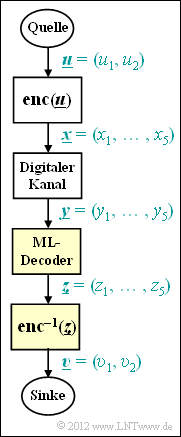Aufgaben:Aufgabe 1.4: Maximum–Likelihood–Entscheidung: Unterschied zwischen den Versionen
Aus LNTwww
Wael (Diskussion | Beiträge) |
Wael (Diskussion | Beiträge) |
||
| Zeile 12: | Zeile 12: | ||
:$$\underline{z} = {\rm arg} \max_{\underline{x}_{\hspace{0.03cm}i} \hspace{0.05cm} \in \hspace{0.05cm} \mathcal{C}} \hspace{0.1cm} {\rm Pr}( \underline{x}_{\hspace{0.03cm}i} \hspace{0.05cm}|\hspace{0.05cm} \underline{y} ) = {\rm arg} \min_{\underline{x}_{\hspace{0.03cm}i} \hspace{0.05cm} \in \hspace{0.05cm} \mathcal{C}} \hspace{0.1cm} d_{\rm H}(\underline{y} \hspace{0.05cm}, \hspace{0.1cm}\underline{x}_{\hspace{0.03cm}i}).$$ | :$$\underline{z} = {\rm arg} \max_{\underline{x}_{\hspace{0.03cm}i} \hspace{0.05cm} \in \hspace{0.05cm} \mathcal{C}} \hspace{0.1cm} {\rm Pr}( \underline{x}_{\hspace{0.03cm}i} \hspace{0.05cm}|\hspace{0.05cm} \underline{y} ) = {\rm arg} \min_{\underline{x}_{\hspace{0.03cm}i} \hspace{0.05cm} \in \hspace{0.05cm} \mathcal{C}} \hspace{0.1cm} d_{\rm H}(\underline{y} \hspace{0.05cm}, \hspace{0.1cm}\underline{x}_{\hspace{0.03cm}i}).$$ | ||
| + | In der Gleichung bezeichnet $d_{\rm H} (\underline{y},\underline{x_{i}})$ die [[Kanalcodierung/Zielsetzung_der_Kanalcodierung#Einige_wichtige_Definitionen_zur_Blockcodierung|Hamming–Distanz]] zwischen Empfangswort $\underline{y}$ und dem (möglicherweise) gesendeten Codewort $\underline{x_{i}}$. | ||
| + | |||
| + | ''Hinweis'': | ||
| + | |||
| + | Die Aufgabe gehört zum [[Kanalcodierung/Kanalmodelle_und_Entscheiderstrukturen|Kanalmodelle und Entscheiderstrukturen]] | ||
===Fragebogen=== | ===Fragebogen=== | ||
Version vom 28. November 2017, 18:28 Uhr
Wir betrachten das digitale Übertragungssystem entsprechend der Grafik. Berücksichtigt sind dabei:
- ein systematischer (5, 2)–Blockcode C mit den Codeworten
- $$\underline{x}_{0} \hspace{-0.1cm} \ = \ \hspace{-0.1cm} (0, 0, 0, 0, 0) \hspace{0.05cm},$$ $$\underline{x}_{1} \hspace{-0.1cm} \ = \ \hspace{-0.1cm} (0, 1, 0, 1, 0) \hspace{0.05cm},$$ $$\underline{x}_{2} \hspace{-0.1cm} \ = \ \hspace{-0.1cm} (1, 0, 1, 0, 1) \hspace{0.05cm},$$ $$\underline{x}_{3} \hspace{-0.1cm} \ = \ \hspace{-0.1cm} (1, 1, 1, 1, 1) \hspace{0.05cm},$$
- ein digitales (binäres) Kanalmodell, das den Vektor x ∈ GF($2^{5}$) in den Vektor $\underline{y} \in {\rm GF} (2^{5}$) verfälscht,
- ein Maximum–Likelihood–Decoder mit der Entscheidungsregel
- $$\underline{z} = {\rm arg} \max_{\underline{x}_{\hspace{0.03cm}i} \hspace{0.05cm} \in \hspace{0.05cm} \mathcal{C}} \hspace{0.1cm} {\rm Pr}( \underline{x}_{\hspace{0.03cm}i} \hspace{0.05cm}|\hspace{0.05cm} \underline{y} ) = {\rm arg} \min_{\underline{x}_{\hspace{0.03cm}i} \hspace{0.05cm} \in \hspace{0.05cm} \mathcal{C}} \hspace{0.1cm} d_{\rm H}(\underline{y} \hspace{0.05cm}, \hspace{0.1cm}\underline{x}_{\hspace{0.03cm}i}).$$
In der Gleichung bezeichnet $d_{\rm H} (\underline{y},\underline{x_{i}})$ die Hamming–Distanz zwischen Empfangswort $\underline{y}$ und dem (möglicherweise) gesendeten Codewort $\underline{x_{i}}$.
Hinweis:
Die Aufgabe gehört zum Kanalmodelle und Entscheiderstrukturen
Fragebogen
Musterlösung
1.
2.
3.
4.
5.
6.
7.
